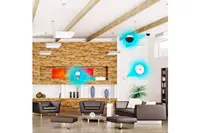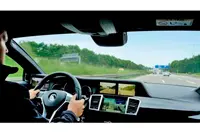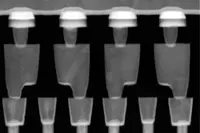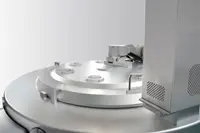Electronics News
Archive : 15 July 2015 год
 Silicon Labs has introduced its Thread networking solution, offering developers the fastest path to developing Thread-compliant products for the IoT including thermostats, wireless sensor networks, smoke/carbon monoxide detectors, connected lighting devices, control panels, wireless access points and gateways.
Silicon Labs has introduced its Thread networking solution, offering developers the fastest path to developing Thread-compliant products for the IoT including thermostats, wireless sensor networks, smoke/carbon monoxide detectors, connected lighting devices, control panels, wireless access points and gateways.
Thread technology is said to fill a critical gap in the IoT ecosystem by providing the industry's first standards-based, low-power mesh networking solution based on Internet Protocol, said to enable reliable, secure and scalable Internet connectivity for battery-powered devices in the connected home.
"Thread is poised to become one of the leading mesh networking technologies for the connected home, with many device manufacturers aligning with Thread technology this year and planning to roll out Thread-enabled products in 2016," said Mareca Hatler, director of research at ON World Inc.
Silicon Labs claims to offer the industry's broadest portfolio of mesh networking SoCs and a common development platform for both ZigBee and Thread solutions. The combination of Silicon Labs' Thread stack, EM35xx wireless SoC platform, and hardware and software tools provides developers with a migration path from ZigBee to Thread via over-the-air upgrades.
"Silicon Labs offers more than a decade of experience in developing, certifying and shipping standards-based mesh networking solutions," said Skip Ashton, vice president of software engineering at Silicon Labs and vice president of technology for the Thread Group. "We have a deep understanding of not only mesh networking technology but also the certification process."
Silicon Labs says its Thread solution offers a simple, secure and scalable way to wirelessly interconnect hundreds of connected home devices and to bridge those devices to the Internet. Thread software provides a self-healing, IPv6-based mesh network capable of scaling to 250+ nodes with no single point of failure and uses banking-class, end-to-end security to join nodes to the network and AES-128 cryptography to secure all networking transactions.
Author
Tom Austin-Morgan
Source: www.newelectronics.co.uk
 Continental has used a prototype vehicle to demonstrate how a camera monitor system can replace a car's exterior and interior mirrors. Instead of the rear-view mirror, the driver has two monitors with organic light emitting diodes (OLEDs) oriented in the usual viewing directions and displaying what is happening at the rear and sides of the vehicle.
Continental has used a prototype vehicle to demonstrate how a camera monitor system can replace a car's exterior and interior mirrors. Instead of the rear-view mirror, the driver has two monitors with organic light emitting diodes (OLEDs) oriented in the usual viewing directions and displaying what is happening at the rear and sides of the vehicle.
In addition to giving the driver a wider field of vision, the system is said to eliminate glare, provide traffic situation detection with driver assistance functions, is much less susceptible to dirt and dust, makes damaged wing mirrors a thing of the past and gives drivers better vision in poor light and rain.
If the approval of these camera-monitor systems goes through as planned in 2016, the systems could already be in use in vehicles starting in 2018.
"There are no blind spots in this camera monitor system. The effects of unwanted optical phenomena such as glare and weak light can also be compensated," said Alfred Eckert, director of the Advanced Engineering department in Continental's Chassis & Safety Division. "By eliminating the wing mirrors, we have created an additional benefit, because the vehicle's air resistance is reduced. The lower air resistance reduces fuel consumption and wind flow noise at higher speeds is diminished."
To provide the best possible display of the lighting conditions on the monitors, the cameras are equipped with a High Dynamic Range (HDR) function that reduces bright sunlight, for example, to a white surface without flare. HDR is also said to improve visibility at dusk.
The image processing system uses the images created by the three cameras to stitch together a corresponding image for each monitor. In addition to the usual mirror images, the driver's field of vision is also expanded by areas the driver could not normally see. For instance, they can use different picture modes to get a view of the side and the rear of the vehicle. Combined with suitable orientation, Continental claims this image stitching prevents any gap in the field of view, especially the accident-prone blind spots of conventional mirrors.
In a holistic HMI, where the existing hardware and software can be dynamically adapted to the driver's needs by networking, digital mirrors expand the possibilities of assisting the driver. They can increase the 'situational awareness' of events in the traffic environment, for instance.
Initial field trials and an in-house study by Continental have shown that digital mirrors are preferred to conventional models. Human testers found that these images were easy to perceive and that the entire system was attractive to use.
Author
Tom Austin-Morgan
Source: www.newelectronics.co.uk
 The Department for Culture, Media and Sport and Innovate UK are encouraging UK cities and businesses to apply for a £10million fund in a competition that will revolutionise the way the Internet of Things (IoT) benefits citizens by offering environmental improvements, economic opportunities, and more efficient and effective delivery of services such as transport, healthcare and energy.
The Department for Culture, Media and Sport and Innovate UK are encouraging UK cities and businesses to apply for a £10million fund in a competition that will revolutionise the way the Internet of Things (IoT) benefits citizens by offering environmental improvements, economic opportunities, and more efficient and effective delivery of services such as transport, healthcare and energy.
Digital Economy Minister Ed Vaizey said: "The IoT is rapidly becoming part of our everyday lives. The UK technology sector is renowned for its creativity and pioneering research and development. This competition will be instrumental in discovering new connections between city services and their users, and identifying many more advantages that the IoT could offer."
A recent report by Arup estimates that the global value of the IoT sector will exceed £255bn a year by 2020. Cities can use IoT to improve services for their citizens, increase quality of life and make better-informed decisions more quickly.
Nick Appleyard, Innovate UK's deputy director for government partnerships, said: "The UK has the opportunity to become a world-leader in this sector, boosting the economy and creating the jobs of tomorrow."
£10m is being offered for a single collaborative research and development project to demonstrate the capability of IoT in a city region. The competition is part of a wider £40m government investment in IoT announced in March 2015.
Projects must be collaborative and led by a local authority or local enterprise partnership (or an equivalent body outside England). Projects should involve at least one local authority, one local enterprise partnership and several businesses. Deadline for registration is at noon on 23 September 2015, with the deadline for applications at noon on 30 September 2015.
Author
Tom Austin-Morgan
Source: www.newelectronics.co.uk
 Imec and Panasonic have fabricated a 2Mbit resistive RAM (RRAM) cell based on TaOx technology on a 40nm process. The approach, said to have precise filament positioning and high thermal stability, is believed to pave the way to realising 28nm embedded applications.
Imec and Panasonic have fabricated a 2Mbit resistive RAM (RRAM) cell based on TaOx technology on a 40nm process. The approach, said to have precise filament positioning and high thermal stability, is believed to pave the way to realising 28nm embedded applications.
RRAM is based on current or voltage induced switching of a resistive element material between two metals. In developing the memory, imec and Panasonic developed a method that overcomes filament instability – one of the critical parameters that impacts the memory state during read operations.
The method uses a combination of process technologies, including low-damage etching, cell side oxidation and an encapsulated cell structure with an Ir/Ta2O5/TaOx/TaN stacked film structure with a filament at the centre of the cell.
The array is said to withstand 100k cycles and to retain data from 10 years at 85°C. Filament control and thermal stability technologies are said to be suitable for the technology to be used at 28nm.
Gosia Jurczak, director of imec's research program on RRAM devices stated: "We have proven the potential of this promising memory concept as embedded nonvolatile memory [at the] 28nm node, where conventional NOR flash shows scaling limitations. This result is a confirmation of our leadership position in research and development on resistive memory."
Author
Graham Pitcher
Source: www.newelectronics.co.uk
 According to Applied Materials, the move to 3D devices is driving demand for atomic layer deposition (ALD) equipment that can enable new patterning films, new conformal materials and lower thermal budgets.
According to Applied Materials, the move to 3D devices is driving demand for atomic layer deposition (ALD) equipment that can enable new patterning films, new conformal materials and lower thermal budgets.
Looking to meet these needs, the company has introduced the Olympia system, which is said to bring the flexibility needed to allow low temperature, high quality films to engineered and deposited precisely.
David Chu, senior director of strategic marketing, dielectric systems and modules, said demand was growing strongly and that he expected the market for ALD technology to be worth $1billion in 2016.
"ALD was all about thickness control in the past," he claimed, "but now, as industry goes to 3D, conformality is also important. And, because 3D structures have active parts, manufacturers need better ALD."
Olympia has a modular architecture, which is said to enable a flexible and rapid process sequence. The modular design also separates chemistries completely, which eliminates the need for the pump and purge steps found in conventional ALD devices. With these steps removed, productivity can increase, with deposition time potentially halved. "Purge is not a value added step," Chu noted
"In Olympia," Chu explained, "chemistries are confined to vertical zones in the chamber. The wafer moves through these zones and is exposed to the various chemistries. The number of revolutions the wafer makes determines the layer thickness."
Chu also believes that Olympia will enable atomic level engineering. "It may open up new classes of films for high volume manufacturing. A lot of films are impractical on conventional ALD, but Olympia will open the door for customers to start thinking engineering films at the atomic level that are better than existing films. And it's not unrealistic to start thinking about thicker films," he concluded.
Author
Graham Pitcher
Source: www.newelectronics.co.uk
 Last month, speakers from around the world came to imec's Technology Forum in Brussels to share their views on what was described as our 'collective digital future'.
Last month, speakers from around the world came to imec's Technology Forum in Brussels to share their views on what was described as our 'collective digital future'.
According to Padmasree Warrior, a strategic advisor at Cisco: "We are currently living through what is quite possibly the most exciting time that I have experienced in the technology industry in more than 30 years. All industries are being affected and whatever vertical you are involved in, you will have to contend not only with new technologies but new competitors, new business models, the pressure for more and faster innovation – all of which are combining to provide a unique and profound moment for us all."
Warrior talked about the gigantic streams of data being generated by sensors being deployed in cars, machinery in factories and from those worn on the body as the 'next big revolution'.
According to many of the speakers, the digital revolution is still in its infancy. Smartphones, tablets, desktop computers and social media are being used to collect and share information, but this is just the start, with dumb objects from fridges to clothes and furniture becoming digitally connected.
According to Lip-Bu Tan, president and CEO of Cadence, smart applications will need to be integrated into a complete system and into a smart environment with everything converging into the cloud.
The theme of the two day forum was smart living and Amazon's Babak Parviz, the former director of the Google X labs, which pioneered the development of Google Glass, talked about the impact of wearable electronics with reference to developments in extreme miniaturisation of electronic systems and declining power consumption.
"This will enable new kinds of wearable computers with enormous computational power and data storage capability provided by the cloud," he suggested.
His reference to wearable computers was mirrored by imec and the Holst Centre, who demonstrated a smart t-shirt with a highly accurate electrocardiogram, capable of recognising activity and which could calculate energy expenditure in an unobtrusive way.
"Wearable technology that measures body parameters has become increasingly popular in recent years. Smart garments have the ability to tackle a vast range of applications from fitness tracking and healthcare monitoring to safety applications, such as firefighters working in dangerous situations. Today, on-body sensing is performed using very tight, compression garments and we wanted to extend the functionality of smart garments and deliver medical-grade data through looser, everyday clothes," said Ruben de Francisco, programme manager for wearable health solutions at imec/Holst Centre.
The t-shirt features a flexible smart fabric interconnect technology and miniaturised electronics integrated into a module of the size of an extended SD card. The device, containing a high accuracy and ultra low power multisensor data acquisition chip with embedded processing, a battery and a Bluetooth Low Energy radio, weighs just 7g.
The rise of the IoT will see an eruption of data. Philip Vandervoort, chief consumer market officer of proximus, talked of a 'traffic explosion' and the need for network providers to provide data rates considerably faster than those seen today with latency at less than 1ms.
This focus on data will mean that servers and data centres will have an increasingly important role to play being at the heart of cloud computing and, according to An Steegen, senior vice president process technology at imec, they will require the most advanced transistor technologies in order to deliver the processing capability to support the amount of data generated by the IoT.
Pic: Padmasree Warrior, strategic advisor at Cisco
Author
Neil Tyler
Source: www.newelectronics.co.uk

